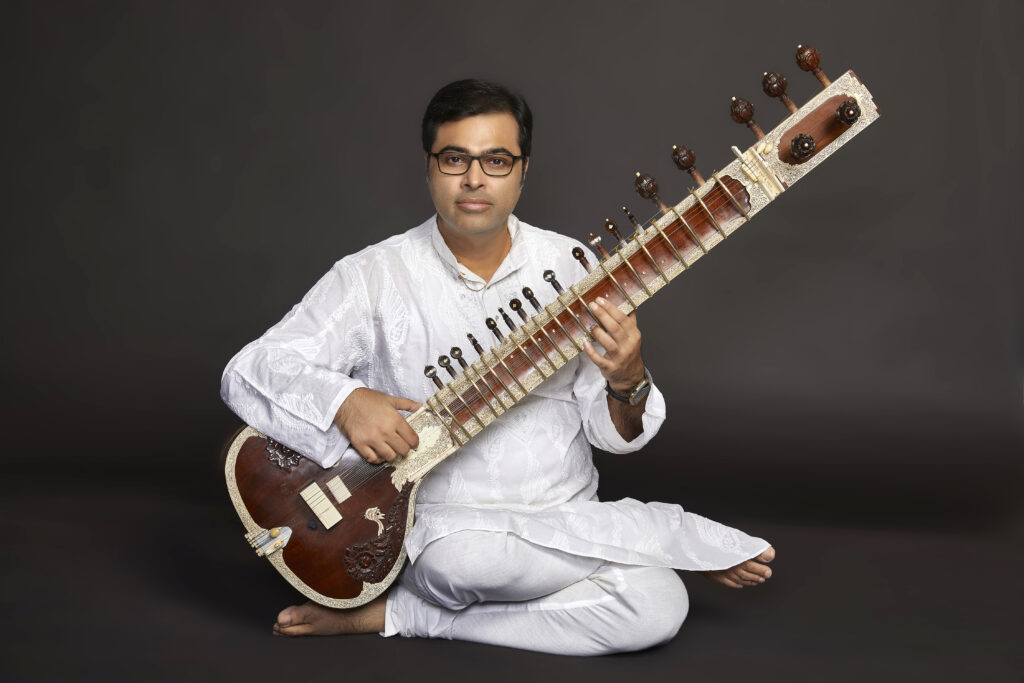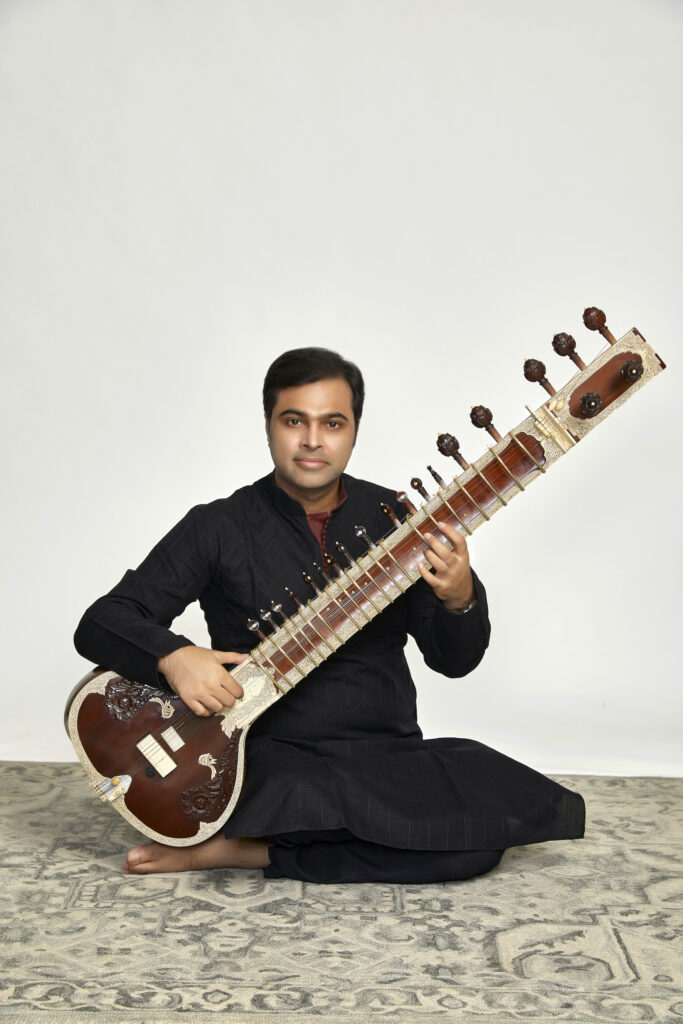Purbayan Chatterjee is a gifted musician who had the privilege of learning sitar at an early age and has been collaborating with global Jazz players across the globe. His newest album ‘Unbounded (Abaad)’ features legendary musicians from across the globe.
Here is a candid conversation with the sitar maestro exclusively for the Score:
How did you start as an artist in the music industry? Talk to us about your formative learning years.
My musical journey started off like any other classical musician, to be honest. With a background of my grandmother who was a classical vocalist, and my father being a sitar guru in Sangeet Research Academy. I started learning sitar when I was five years old, and before that I was trained in vocal music as well.
I grew up in a strict classical environment and had even resisted western music initially. I was not very aware of music beyond Hindustani classical, that was confined to traditional style. It was a very rigorous training schedule for 5/7-year-old boy who was more excited about cricket at that age! After crossing 12-13 years of age, I started falling in love with the greatness of classical music and other forms of music.
Fusion music has become really popular amongst all age groups of people across the globe. How do you look at this form of music?
Using the term fusion music to represent two different forms of music together, is not as experimental as it sounds. Every form of music, traditional music included, is an amalgamation of two or more facets of music. The instrument,sitar itself has faced fusion influences with the Mughal invasions and Persian elements as well.
The whole of Hindustani music that we call today, and the way we play khayal is indeed fusion. This is an ever-continuing process and it will go on. I am totally for fusion, but the only way culture survives is by imbibing other cultures.
There is absolutely no negative impact but the need of the hour is awareness, to make the students make aware of the elements of music, enough to know about fusing them.

You are known for your remarkable collaborations with fantastic artists across genres. Could you talk to us about your process of selecting people you want to work with? Do you decide on the sound first or do artists come first?
I am glad to had the opportunity to work with legends for this new album ‘Unbounded (Abaad)’ and would like to thank Sufiscore for making us do it. I had the wildest wish list and when I shared it with these artists, it was almost like someone sprinkled magical dust over it to make it happen.
The initial list was smaller, but as we went on, the list expanded and the album evolved. I always loved jazz music and it was an obvious choice for an improvisational music form. Jazz and classical Music have this greatly in common.
The improvisation is governed by intricate set of rules and the framework is designed meticulously. This album was like a magical wishlist for sure, and I am thankful to all the masters who contributed to the album.
I must mention Ustad Zakir Hussain and Pt Ravi Shankar Saab who took our music to a global arena. I am also thankful to Béla Fleck who would usually not come around for a fusion album of this sort.
Do you think an artist will have a limitation to express the lyrical beauty of a composition on an instrument? What is your approach for it?
Showing the lyrical component through an instrument is a constant quest for me. Picking up every ornament sung by the vocalist through sitar rendition is one way to express the lyrics.
Whether it is a complex composition or a filmy number, this rule holds good. When we were working on this album Unbounded (Abaad), we were focused on the lyrics and that the music should reflect the mood of the each word rendered.
According to you, what’s the biggest challenge for a sitar player?
I think there is less of an awareness throughout the world about instrumental music. Though it is much better in the West with conservatories, how the music is perceived, and the individual understanding about each instrument such as timpani, drums, strings and so on.
The students are educated about all these aspects. This is somehow missing in our own educational system in India. I believe this should be a part of basic education, as it is part of history, culture and music. Whether you are a musician or not, these aspects have to be learnt by every person.
You have been performing actively for nearly three decades now. How do you keep yourself motivated and grow on a consistent basis, as a musician?
This question is very relevant in current times of pandemic where no live performances are happening at all and it is very difficult to keep the spirits going. However, this is only the smaller picture. The larger picture is about keeping oneself motivated, and feeling the burnout and demotivated after hectic schedules and the music gets jaded.
Every performance feels like a same old drill and becomes monotonous. It is important to reinvent yourself on a daily basis, to be motivated and energised.
For example, I am practising the raag Chhayanut which is rarely performed on the sitar. Creating a new raag, a rhythmic cycle or challenging yourself will definitely keep the motivation up. The heart of an artist is expansive and it should continue to fly without bounds. Being jaded will lead you to become lazy and without realizing, it will take the fun off your music.
I always suggest listening to different styles of music by bombarding your mind with different kinds of music and it will surely bring new ideas flowing.
In this process, I have also created a new raag called Sahasra Deep which is a combination of raags Patdeep and Shahana.
How did you use the changing times of tech to your advantage, by collaborating with interesting artists?
The pandemic has been a great wake up call for many and I was no exception. I was thinking of putting out more music in the digital space, just before the pandemic began. If you see in the West, the streaming platforms have been generating revenues for a while.
I thank my good friend and composer Shantanu Moitra who informed me about classical music present on digital platforms and how professionally it is made for this space. That got me thinking and when the pandemic arrived, digital platforms was the only way to put music forth.
I was always focused on quality and the way it is mixed to give the perfect listening experience. I was learning the hacks of mixing and I could work with Aditya Srinivasan, who did amazing mixing and the main mixing was done by Christian Wright from Abbey Road studios who mixed the popular number “Shape of You” by Ed Sheeran.
I could also work with Mahesh Raghavan who plays on the iPad and Darshan Doshi who plays the drums. We all got together as a band named Live & In sync. We created an environment where we could play together in time in the digital space.

What motivated you to design an innovative instrument Doppelganger where old school sound meets digital tech?
I called it the doppelganger of sitar and it does look fancy. The actual name I gave it is See-Tar. It is visual more than anything else, and the reason for creating it is to give a theatrical element for my shows. The theatrical entry with lights, colours that embodies the music is the main motivation behind it.
I also made a solid body electric sitar that has technical sounds but I again confined to acoustic version of sitar alone. The organic sound is what I kept intact throughout the album, so that the traditional flavour is deeply rooted. I’d like to bring my original sound when it comes to sitar.
Out of all the world genres, what was the toughest genre for you to blend in? And how did you overcome it?
Jazz is toughest for sure because of its intellectual possibilities and scope of improvisation. If you observe syncopated or chromatic jazz, one has to use all the 12 chromatic notes at the best possible manner.
There is so much of intelligence involved in the songwriting, and after working with masters in the genre – it is amazing to see how Ustad Zakir Hussain blends with these jazz legends. The unlikely combination of Indian classical and progressive rock is something we did in our album Unbounded (Abaad).
Being awarded as the best instrumentalist of the country at a young age of 15, how did you build on it? What do awards mean to you?
For five days after getting the award, you are thrilled for sure and for a few it can last longer as well. The lesser the time of the thrill, the better it is to move on from it and start all over again. It is always a new day and one needs to do music all over again and awards may not matter then.
You need to continuously touch people’s hearts by reinventing yourself with music and understanding about it. However, life may change after getting recognised by an honorary award but the reinvention continues!
Can you please tell us more about the gear you use in your recordings, and with home studio performances?
I am totally an Apple guy and most of my gadgets are from the Apple ecosystem. I use an Apple computer, and I have an Apple G Sound card that is fantastic. I also have a Sapphire Pro Focus Riot Soundcard but I recently discovered a mic called AppleG USB mic called Hype G which has punchy compression of sound. It is easy to plug in and I could do recordings for TV with it!
Along with the sound setup, I also use a ring light and have a dual light arrangement for a better video quality for my performance. I am a bit of a geek and I have a thing for playing around with these tech stuff.
Rapid Fire
3 main aspects a budding sitar player must keep in mind?
I might sound cliché, but it is practice, practice and practice.
A dream venue to perform
It is totally crazy but, it is Colosseum in Rome.
An artist collaboration of your dream
Jacob Collier
Another instrument you can play apart from the Sitar
I play the harmonium (while accompanying my wife for her ghazal renditions) and a bit of tabla as well.
Do Follow
Instagram – https://www.instagram.com/purbayanch/







